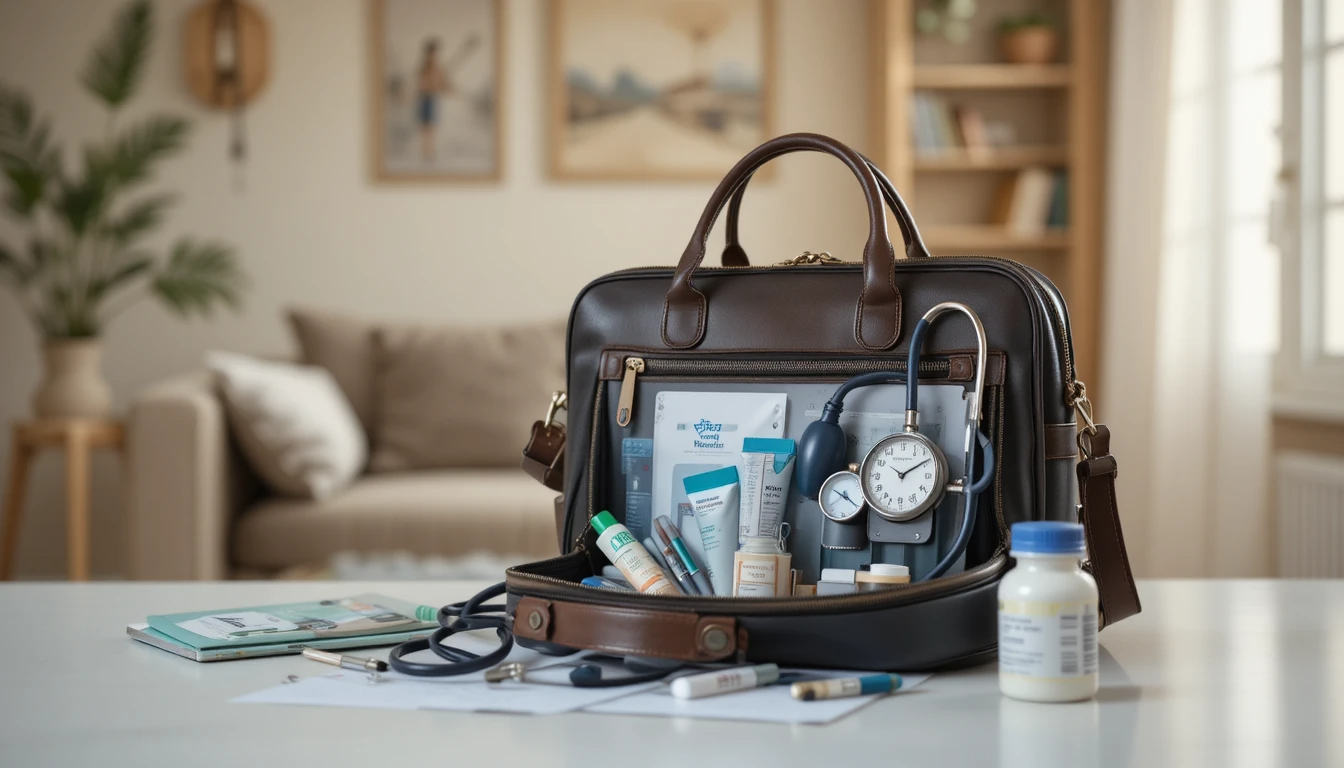In medicine, being prepared can make the difference between a smooth consultation and a medical emergency. For home-visit doctors, readiness isn’t just a professional standard — it’s a lifeline. Whether responding to a sudden illness, conducting routine check-ups, or managing post-hospital care, a doctor’s efficiency depends on what they carry.
A well-organized doctor’s bag has long symbolized trust, expertise, and preparedness. While technology has transformed healthcare delivery, the timeless importance of having essential tools within reach remains unchanged. Let’s explore why a properly equipped doctor’s bag is an indispensable part of every home doctor’s practice.
History and Symbolism of the Doctor’s Bag
The doctor’s bag has been a companion of medical professionals since the 19th century. Originally made from leather with a distinctive hinged opening, it was designed for doctors making house calls in rural areas. Inside, you’d find diagnostic tools, basic medications, and sterile instruments — everything a physician needed to handle emergencies before hospitals became widespread.
More than just a storage accessory, the doctor’s bag represented reassurance. For patients, seeing a doctor arrive with their trusted bag meant help had arrived. Over time, the bag evolved in both design and function, adapting to modern medical needs. Today, it’s no longer just a vintage symbol — it’s a mobile medical unit, blending tradition with innovation.
Modern bags are built with durable materials, multiple compartments, and easy-to-clean interiors. They come in variations suitable for general practitioners, emergency responders, and specialists. Whether made from sleek leather or lightweight synthetics, the essence remains the same: readiness, organization, and professionalism.
Why a Well-Equipped Bag Matters for Home Doctors
When working outside a clinical environment, a doctor’s effectiveness depends on immediate access to the right tools. Every second counts in emergencies, and a fully stocked medical bag ensures the doctor can provide timely care without relying on external facilities.
Immediate Response
Emergencies can happen anywhere — a patient struggling to breathe, a child with a severe fever, or an elderly person in distress. Having diagnostic tools and first-line treatments on hand allows the doctor to act immediately.
Patient Trust
Patients feel more at ease when a doctor arrives prepared. The presence of an organized bag communicates competence and confidence, building trust even before treatment begins.
Professional Efficiency
A structured doctor’s bag reduces stress during visits. Everything has its place, minimizing time spent searching for items and ensuring smooth consultations.
In short, a well-equipped bag isn’t a convenience — it’s an extension of the doctor’s skill and responsibility.
Core Essentials Every Doctor’s Bag Should Include
The contents of a doctor’s bag vary depending on specialization, but a few essentials remain constant.
Diagnostic Tools
-
Stethoscope: For listening to heart and lung sounds.
-
Blood pressure monitor: A vital tool for assessing cardiovascular health.
-
Thermometer: Essential for detecting fever or infection.
-
Pulse oximeter: Measures oxygen levels, crucial in respiratory cases.
Basic Instruments
-
Scissors and forceps: For dressing wounds and minor procedures.
-
Pen torch: For checking pupil reaction and throat examinations.
-
Disposable gloves: To maintain hygiene and prevent contamination.
-
Hand sanitizer and disinfectant wipes: For infection control.
Medications and Supplies
-
Pain relievers and antipyretics: For pain and fever management.
-
Antihistamines: For allergic reactions.
-
Antibiotics: For infection management when appropriate.
-
Emergency drugs: Such as epinephrine for severe allergic responses.
-
Dressings, gauze, and bandages: For treating cuts, burns, or wounds.
Documentation and Tech
-
Prescription pad and ID: For issuing medications and maintaining professionalism.
-
Tablet or smartphone: For accessing medical records or teleconsultation apps.
-
Portable ECG or glucometer: Helpful for on-the-spot diagnostic assessments.
A reliable bag keeps these essentials in clearly marked compartments for quick retrieval — because in urgent moments, order saves time.
Modernizing the Doctor’s Bag: From Leather to Smart Kits
Today’s healthcare environment is fast-paced and tech-driven. Modern doctor’s bags have adapted accordingly. Instead of bulky leather satchels, contemporary versions are lightweight, ergonomic, and often feature smart storage solutions.
Some include built-in cooling compartments for temperature-sensitive medications, anti-microbial linings to maintain hygiene, or digital trackers to prevent misplacement. Adjustable sections allow customization, so doctors can reconfigure compartments to match their field — whether general practice, pediatrics, or geriatric care.
Even design has evolved. Doctors can now choose professional yet stylish models that reflect their personal brand while still offering durability and function. The goal is to merge classic craftsmanship with modern practicality.
Customizing the Doctor’s Bag Based on Specialization
No two medical practices are the same, and neither should their bags be. A pediatrician’s kit will differ greatly from a general practitioner’s or a home-care nurse’s setup.
For General Practitioners
The focus is on versatility — diagnostic tools, basic medications, and wound-care materials. The goal is to handle a broad range of conditions confidently.
For Pediatricians
Pediatric-friendly thermometers, dosage syringes, and flavored medications make treating children easier. Adding comforting touches, like stickers or toys, can help calm young patients.
For Geriatric or Palliative Care Doctors
Equipment like portable ECGs, blood glucose monitors, and pain management supplies take priority. Comfort items such as gentle antiseptics and mobility aids may also be included.
For Specialists
A cardiologist may include portable diagnostic devices, while a physiotherapist might carry assessment tools and muscle-relief items. The beauty of a customizable doctor’s bag is that it adapts to the professional’s unique requirements.
Maintenance and Hygiene: Keeping the Bag Ready at All Times
A neglected medical bag can compromise both hygiene and performance. Keeping it clean, restocked, and organized is as important as its initial setup.
Regular Cleaning
After every visit, disinfect instruments, wipe down surfaces, and dispose of used materials properly. Choose bags made with water-resistant, wipeable interiors to simplify maintenance.
Inventory Checks
Create a monthly checklist to restock medications, replace expired items, and recharge electronic devices. A quick five-minute audit before leaving for appointments ensures you’re always ready.
Organization Tips
Use color-coded pouches or labeled compartments to separate medication types, sterile items, and diagnostic tools. This minimizes the chance of cross-contamination and confusion.
A clean, organized bag not only supports safety but also reinforces your professionalism with every patient interaction.
Role of the Doctor’s Bag in Building Patient Confidence
In home healthcare, first impressions are crucial. When a doctor arrives carrying a well-maintained medical bag, it sends an immediate signal of reliability. It tells patients: “You’re in safe hands.”
Preparedness builds trust. Patients are more likely to follow medical advice when they see their doctor is ready for every possibility. Beyond the physical tools, the bag becomes a symbol of reassurance — a reminder that even outside the hospital, expert care is just a call away.
For many, the sight of a doctor opening their bag brings comfort, evoking generations of healing and professionalism. It bridges the old world of house calls with the modern era of personalized medicine.
Also Read: Get Echoxen Honest Review & Improve Ear Health
Conclusion
In an age of digital healthcare and remote consultations, the humble doctor’s bag continues to hold its ground as an essential part of medical practice. It represents readiness, skill, and compassion — qualities that define great doctors everywhere.
A well-equipped doctor’s bag isn’t just about convenience; it’s about being prepared to deliver care anytime, anywhere. For home-visit doctors, it’s a trusted partner — one that turns preparation into peace of mind, and professionalism into patient trust.




Leave a Reply